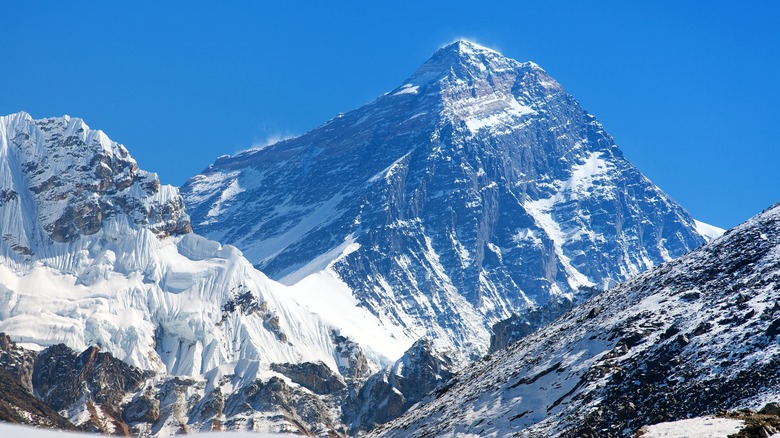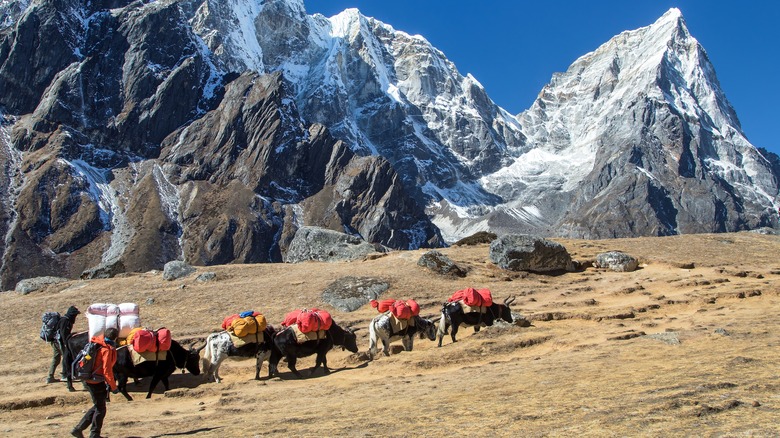Mount Everest's Dangerous Weather Puts Hikers And Basecamp Trekkers In Danger, Not Just Mountaineers
It's the ultimate bucket list destination and every trekker's dream: climbing Mount Everest. But for those ascending the highest mountain in the world in October 2025, that dream turned into a nightmare. On October 3, a massive blizzard swept across the Gama Valley, a remote, ancient forest on the mountain's eastern side, accessible only by yaks and mules on a journey that typically takes 10 days. An estimated 1,000 climbers — some of whom were experienced mountaineers and return visitors — were trapped on one of the world's most unforgiving ascents as the storm raged through the night. Many were wearing only rain jackets or windbreakers and hunkered down in tents, which they had to constantly clear of snow to avoid collapse.
The rare storm struck during China's Golden Week holiday, coinciding with the Mid-Autumn Festival, a major celebration in various East and Southeast Asian cultures. The climbers had reached elevations of around 16,000 feet — just over halfway to the 29,000-foot summit — when the blizzard hit. According to early reports, including from one hiker who managed to descend ahead of the storm, tents were crushed and temperatures plunged rapidly, with some climbers already experiencing hypothermia.
Rescue efforts began immediately, with teams working to clear paths for trapped climbers to descend. As of October 8, roughly half had either reached temporary safety or established contact with emergency teams. Around 580 hikers and more than 300 porters and guides have regrouped at a meeting point in Tibet's Tingri county, but at least one hiker is reported dead, and 200 others are still stranded. Ticket sales have been suspended by the Tingri County Tourism Company in the meantime, and Tibet's scenic Mount Everest area has closed temporarily.
The region's weather has been worsening
For Chen Geshuang, a member of the hiking group caught up in the blizzard, the storm was overwhelming despite her group's experience. "The weather this year is not normal. The guide said he had never encountered such weather in October," she told Reuters. "And it happened all too suddenly." Typically, October brings clear and mild conditions to this part of Everest, making it one of the most popular months for climbing. Mount Everest is an interesting region, challenging to ascend even under normal circumstances — with its unpredictable weather, thin air, and extreme terrain. This unseasonably early snowstorm was unusually intense, but it wasn't the only anomalous weather the region has dealt with lately. Elsewhere in China, early snowstorms blocked roads, stranded travelers, and caused at least one death.
Climate change is slowly destroying iconic destinations around the world, particularly amplifying both the unpredictability and the dangers of the Himalayas. Even experienced sherpa communities have been forced to adapt to the frequent and extreme shifts in weather — including blizzards in October — making it all the more dangerous for travelers and tourists, even experienced trekkers. In addition to volatile storm patterns, overall increased global temperatures cause thaw and glacial melt, which trigger rockslides, creating even more danger.
In Nepal, one of the countries that Mount Everest straddles, recent severe floods have washed away bridges and roads, killing nearly 50 people and triggering landslides as far away as Darjeeling, in neighboring India. Meanwhile, Typhoon Matmo has battered southern coastal China, grounding flights, forcing 350,000 evacuations, flooding roads, and disrupting business as the country goes on red alert. The storm's aftermath has now reached Vietnam, causing torrential rain and flooding, killing at least eight people.

